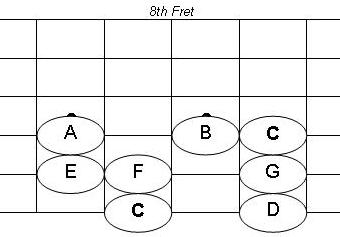In Confession #18 - Slash Chords! we learned the meaning of chord names such as C/G, or D/F#, and learned how slash chords can bring a fresh and interesting sound to chord progressions because they use different chord voicing.
Another application for slash chords is called voice leading.
C-G-Am-G Chord Progression
Let's take a look at a I-V-vi-V chord progression in the key of C (see Confession #14 - Know What Chords to Play! if you aren't sure what a I-V-vi-V progression is). Thus, the chords in this progression are: C - G - Am - G.
If we play these chords using standard open chords, the lowest sounding notes (i.e. the notes with the lowest pitch) will be the root notes of each chord. Our ear actually distinguishes these low notes from the other notes being played and hears them like a bassline.
The notes of this bassline are: C - G - A - G (i.e. the root notes of each chord). The movement of this bassline is:
- start on C,
- down 5 semi-tones,
- up 2 semi-tones, and
- down 2 semi-tones.
C-G/B-Am-G Chord Progression
Now let's take this same progression and change the voicing of the first G chord by using a G/B slash chord. Thus, the chords in this progression are: C - G/B - Am - G.
As we learned in Confession #11 - Learn Root 6 Barre Chords! the notes of a G chord are G, B and D. Here's what a G/B chord looks like:
 |
| G/B - Notes shown in order from fifth string to second string (Click to enlarge) |
Putting the B in the "bottom of the chord" (i.e. the lowest pitched note in the chord) in the first G chord changes the bassline.
Now the notes of the baseline are C - B - A - G (i.e. not all root notes of the chords). The movement of this bassline is:
- start on C,
- down 1 semi-tone,
- down 2 semitones, and
- down 2 more semi-tones.
As demonstrated in the following example, our ears can hear the difference in the movement suggested by the two different basslines. The second progression has a different feel than the first because the bass notes descend with each chord change.
You've probably heard songs with a steadily descending movement with each chord change. This is how that effect is achieved.
Voice Leading
Choosing a chord tone other than the root note as the lowest note in a chord can be used to change the feel and movement of the bassline in a chord progression. This is called voice leading.
Try experimenting with this technique in your songs. To use it effectively, you'll need to know the chord tones of each chord in your progression and then look for different ways to voice the chords so that you can get the bass note you want in the "bottom of the chord".
Next Week's Confession - Fret Hand Muting!






